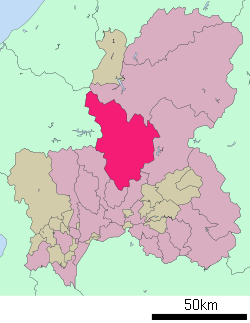Gujō, Gifu
| Gujō 郡上市 | |||
|---|---|---|---|
| City | |||
 | |||
| |||
 Location of Gujō in Gifu Prefecture | |||
 Gujō | |||
| Coordinates: 35°44′54.8″N 136°57′51.6″E / 35.748556°N 136.964333°ECoordinates: 35°44′54.8″N 136°57′51.6″E / 35.748556°N 136.964333°E | |||
| Country | Japan | ||
| Region | Chūbu | ||
| Prefecture | Gifu | ||
| Government | |||
| • Mayor | Toshiaki Hioki[1] | ||
| Area | |||
| • Total | 1,030.75 km2 (397.97 sq mi) | ||
| Population (November 1, 2017) | |||
| • Total | 44,723 | ||
| • Density | 43/km2 (110/sq mi) | ||
| Time zone | UTC+9 (Japan Standard Time) | ||
| City symbols | |||
| - Tree | Maple | ||
| - Flower | Magnolia kobus | ||
| Phone number | 0575-67-1121 | ||
| Address | 228 Shimatani, Hachiman-chō, Gujō-shi, Gifu-ken 501-4297 | ||
| Website | Official website | ||

Gujō (郡上市 Gujō-shi) is a city located in Gifu, Japan. As of 31 October 2017, the city had an estimated population of 44723, and a population density of 43 persons per km2, in 15,328 households.[2] The total area of the city was 851.21 square kilometres (328.65 sq mi).
Geography
Gujō is located in west-central Gifu Prefecture. The headwaters of the Nagara River are in the city.
Waterways
Gujō's famous pristine waterways operate the same way as they did in the 17th century. The canals, fountains, and waterways are still used for washing rice, vegetables, and laundry. Townspeople cooperate to keep the canals clean and the water fresh; as a result of their efforts, Gujō's drinking water is a source of local pride. Gujō Hachiman is in a valley where three major fast-running rivers meet: the Yoshida, Nagara and Kodara. Visitors come to enjoy the pure mineral water that flows from every tap in town. The clean water and sound environmental practices translate into good food and drink. Ayu, soba, and sake all depend on water for their flavor.[3] Some residents can be seen using the town's unique system of small waterways to wash laundry and dishes following a very strict set of rules that describe what may be washed where. This practice has survived for centuries and ensures that all households have access to clean water.[3]
Climate
The city has a climate characterized by characterized by hot and humid summers, and mild winters (Köppen climate classification Cfa). The average annual temperature in Gujō is 13.6 °C. The average annual rainfall is 2569 mm with September as the wettest month. The temperatures are highest on average in August, at around 26.6 °C, and lowest in January, at around 1.3 °C.[4]
Neighbouring municipalities
Demographics
Per Japanese census data,[5] the population of Gujō ro has declined steadily over the past 40 years.
| Census Year | Population |
|---|---|
| 1970 | 54,146 |
| 1980 | 52,690 |
| 1990 | 50,986 |
| 2000 | 49,377 |
| 2010 | 44,491 |
History
The area around Gujō was part of traditional Mino Province. During the Edo period, most of the area was under the control of Gujō Domain under the Tokugawa shogunate. During the post-Meiji restoration cadastral reforms, the area was organised into Gujō District, Gifu. The town of Hachiman of created on July 1, 1889 with the establishment of the modern municipalities system. The modern city of Gujō was established on March 1, 2004, from the merger of the towns of Hachiman, Shirotori and Yamato, and the villages of Meihō, Minami, Takasu and Wara (all from Gujō District).[6]
Government
Gujō has a mayor-council form of government with a directly elected mayor and a unicameral city legislature of 18 members.
Economy
Food replicas
Gujō is a leading producer of food replicas in Japan. Many of the food replicas, used by restaurants to decorate their windows and inform patrons of their dishes, are produced here.
Education
Gujō has 22 public elementary schools and eight public middle schools operated by the city government, and two public high school operated by the Gifu Prefectural Board of Education.
Transportation
Railway
- Nagaragawa Railway Etsumi-Nan Line
- Hanno - Konno - Yasaka - Minami-Kodakara-Onsen - Ōya - Fukuno - Minami-Kariyasu - Akaike - Fukado - Aioi - Gujō-Hachiman - Shizen'en-mae - Yamada - Tokunaga - Gujō-Yamato - Manba - Kamimanba - Ōnaka - Ōshima - Mino-Shirotori - Shirotori-Kōgen - Hakusan-Nagataki - Hokunō
Highway
Local attractions

Gujō Odori
The famous dance festival — Gujō Odori — attracts many visitors. The festival started over 400 years ago and continues today. During the four days of Obon in mid-August, dances continue all night. The dance begins on the same night as Kyoto's Gion Festival and continues for 30 nights. It begins at the Yasaka Shrine and moves to another one each night. The Gujō Odori Preservation Society tell musical stories through an "ohayashi" which consists of a soloist, a shamisen, a taiko, and a shakuhachi.[7] Listeners participate by dancing around the stage. During "Urabon" (August 13 to 16) the dancing continues until 5:00am. More than 20,000 visitors come to town for the odori.[7]
References
- ↑ 市長の部屋. Gujo official website (in Japanese). Gujo city. Retrieved 8 August 2011.
- ↑ Official home page
- 1 2 http://www.gujohachiman.com/kanko/index_e.htm Gujo Hachiman Water
- ↑ Gujō climate data
- ↑ Gujō population statistics
- ↑ 市政 > 郡上市の紹介 > 郡上市の歴史 > 近代(明治・大正・昭和時代). Gujo official website (in Japanese). Retrieved August 17, 2011.
- 1 2 http://www.city.gujo.gifu.jp/english/tourism_and_amusement/ Gujō City tourism and amusement guide
External links

- Official website (in Japanese)